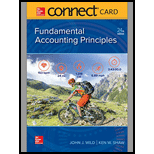
Concept explainers
Concept Introduction:
Corporate Income Tax liabilities:
As corporate bodies are liable to pay Income taxes and deposit the income taxes due at the end of each quarter, they must record Income Taxes based on estimates every month and then adjust the amount to Income tax actually due quarterly. When income tax expenses are recorded, Tax expenses are debited and Income Tax payable is credited. On payment of Income Taxes to the department, the Income Tax payable account is debited and cash is credited.
Requirement 1:
To compute:
The amount of the accounting adjustment to be made in the Income Tax Payable
Concept Introduction:
Corporate Income Tax liabilities:
As corporate bodies are liable to pay Income taxes and deposit the income taxes due at the end of each quarter, they must record Income Taxes based on estimates every month and then adjust the amount to Income tax actually due quarterly. When income tax expenses are recorded, Tax expenses are debited and Income Tax payable is credited. On payment of Income Taxes to the department, the Income Tax payable account is debited and cash is credited.
Requirement 2:
To provide:
Want to see the full answer?
Check out a sample textbook solution
Chapter 11 Solutions
Connect Access Card For Fundamental Accounting Principles
- I am searching for the correct answer to this general accounting problem with proper accounting rules.arrow_forwardPlease explain the solution to this financial accounting problem with accurate principles.arrow_forwardKodak Inc. sells its product for $95 per unit. During 2023, it produced 85,000 units and sold 68,000 units (there was no beginning inventory). Costs per unit are: direct materials $22, direct labor $19, and variable overhead $6. Fixed costs are: $1,275,000 manufacturing overhead, and $127,000 selling and administrative expenses. The per-unit manufacturing cost under absorption costing is__. Helparrow_forward
- Your boss asks you to compute the company's cash conversion cycle. Looking at the financial statements, you see that the average inventory for the year was $157,800, accounts receivable were $128,500, and accounts payable were at $143,600. You also see that the company had sales of $412,000 and that cost of goods sold was $346,000. What is your firm's cash conversion cycle? Round to the nearest day.arrow_forwardI am trying to find the accurate solution to this financial accounting problem with the correct explanation.arrow_forwardI need help with this financial accounting question using the proper financial approach.arrow_forward

 AccountingAccountingISBN:9781337272094Author:WARREN, Carl S., Reeve, James M., Duchac, Jonathan E.Publisher:Cengage Learning,
AccountingAccountingISBN:9781337272094Author:WARREN, Carl S., Reeve, James M., Duchac, Jonathan E.Publisher:Cengage Learning, Accounting Information SystemsAccountingISBN:9781337619202Author:Hall, James A.Publisher:Cengage Learning,
Accounting Information SystemsAccountingISBN:9781337619202Author:Hall, James A.Publisher:Cengage Learning, Horngren's Cost Accounting: A Managerial Emphasis...AccountingISBN:9780134475585Author:Srikant M. Datar, Madhav V. RajanPublisher:PEARSON
Horngren's Cost Accounting: A Managerial Emphasis...AccountingISBN:9780134475585Author:Srikant M. Datar, Madhav V. RajanPublisher:PEARSON Intermediate AccountingAccountingISBN:9781259722660Author:J. David Spiceland, Mark W. Nelson, Wayne M ThomasPublisher:McGraw-Hill Education
Intermediate AccountingAccountingISBN:9781259722660Author:J. David Spiceland, Mark W. Nelson, Wayne M ThomasPublisher:McGraw-Hill Education Financial and Managerial AccountingAccountingISBN:9781259726705Author:John J Wild, Ken W. Shaw, Barbara Chiappetta Fundamental Accounting PrinciplesPublisher:McGraw-Hill Education
Financial and Managerial AccountingAccountingISBN:9781259726705Author:John J Wild, Ken W. Shaw, Barbara Chiappetta Fundamental Accounting PrinciplesPublisher:McGraw-Hill Education





